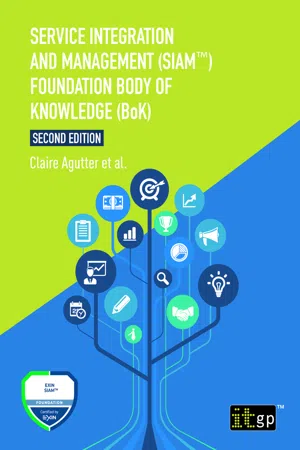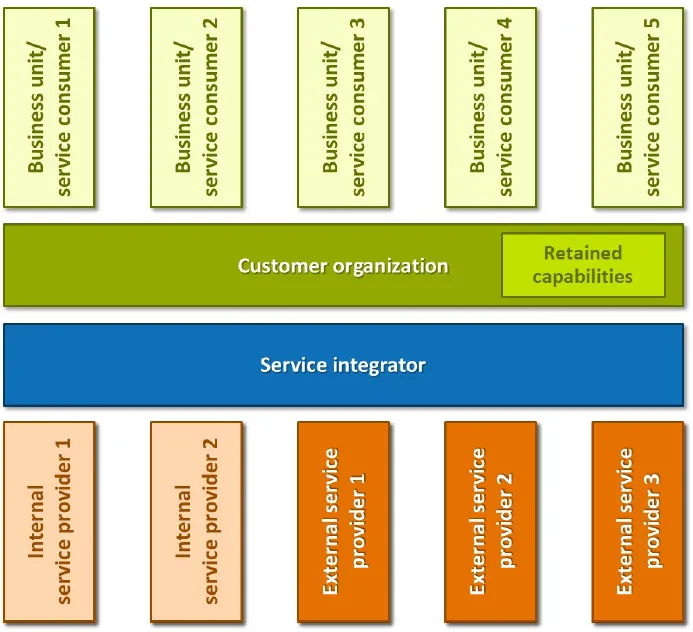![]()
CHAPTER 1: INTRODUCTION TO SERVICE INTEGRATION AND MANAGEMENT (SIAM)
1.1 What is SIAM?
Service integration and management (SIAM) is a management methodology that can be applied in an environment that includes services sourced from a number of service providers.
SIAM has a different level of focus to traditional multi-sourced ecosystems with one customer and multiple suppliers. It provides governance, management, integration, assurance and coordination to ensure that the customer organization gets maximum value from its service providers.
SIAM governance operates at three levels in the ecosystem:
•Strategic
•Tactical
•Operational
SIAM is an evolution of how to apply a framework for integrated service management across multiple service providers. It has developed as organizations have moved away from outsourced contracts with a single supplier to an environment with multiple service providers. SIAM has evolved from the challenges associated with these more complex operating models.
SIAM supports cross-functional, cross-process and cross-provider integration. It creates an environment where all parties:
•Know their role, responsibilities and context in the ecosystem
•Are empowered to deliver
•Are held accountable for the outcomes they are required to deliver
SIAM introduces the concept of a service integrator, which is a single, logical entity held accountable for the end-to-end delivery of services and the business value that the customer receives.
Terminology
SIAM is the generally accepted acronym for service integration and management.
Other acronyms that are in use are:
•MSI (Multi-sourcing Integration)
•SMI (Service Management Integration)
•SI (Service Integration)
•SMAI (Service Management and Integration)
•SI&M (Service Integration & Management)
SIAM can be applied to different sizes and types of organization, and to different industry sectors. Customers that only require a single service provider are unlikely to get the full value from SIAM.
SIAM can be applied to environments that include external service providers only, internal service providers only, or a combination of internal and external service providers. The effectiveness of SIAM and the value it delivers will increase as the number of service providers and the number of interactions between services increase.
Some organizational cultures are more able to adapt to SIAM than others. Effective SIAM requires control to be balanced with trust, devolution of responsibilities, openness, and collaboration across all parties. A transition to SIAM is likely to require significant changes in attitude, behavior, and culture in ecosystems that previously relied on command-and-control structures for effective service delivery.
The SIAM methodology encompasses:
•Practices
•Processes
•Functions
•Roles
•Structural elements
The customer organization will transition to a SIAM model developed from these elements.
1.1.1 The SIAM ecosystem
There are three layers in a SIAM ecosystem:
1.Customer organization (including retained capabilities)
2.Service integrator
3.Service provider(s)
Each layer has a role as part of effective end-to-end management of services and the delivery of maximum value. Each layer should have sufficient capability and maturity to fulfil its role.
1.1.1.1 Customer organization
The customer organization is the end client that is making the transition to SIAM as part of its operating model. It commissions the SIAM ecosystem.
Customer organizations typically contain business units such as human resources, finance, sales and their own internal IT function. They also have their own customers that use their products and services.
Figure 1 shows the layers of the SIAM ecosystem, and the consumers of services from the customer organization.
Figure 1: The SIAM layers, including consumers of services from the customer organization
In this book, we use the terms ‘customer organization’ and ‘customer’ to mean the commissioning organization.
The customer organization will own the contractual relationships with external service providers, and with any external service integrator.
1.1.1.2 Retained capabilities
The customer organization will include some retained capabilities. The retained capabilities are the functions that are responsible for strategic, architectural, business engagement and corporate governance activities.
These business-differentiating functions typically remain under the direct control and ownership of the customer organization. Retained capabilities also include any accountabilities and responsibilities that must remain with the customer for legislative or regulatory reasons.
Examples of possible retained capabilities are:
•Enterprise architecture
•Policy and standards management
•Procurement
•Contract management
•Demand management
•Financial and commercial management
•Service portfolio management
•Corporate risk management
•Governance of the service integrator; based on achievement of business outcomes
The service integrator is independent from the retained capabilities, even if it is internally sourced. Service integration is not a retained capability.
Retained capabilities are sometimes referred to as the ‘intelligent client function’.
1.1.1.3 Service integrator
The service integrator layer of the SIAM ecosystem is where end-to-end service governance, management, integration, assurance and coordination is performed.
The service integrator layer focuses on implementing an effective cross-service provider organization, making sure that all service providers are contributing to the end-to-end service. It provides operational governance over the service providers and has a direct relationship with the customer organization and the service providers.
The service integrator layer can be provided by one or more organizations, including the customer organization. If the service integrator layer is provided by more than one organization, it should still be considered a single logical service integrator.
The service integrator can include one team of people or multiple teams.
1.1.1.4 Service provider
Within a SIAM ecosystem, there are multiple service providers. Each service provider is responsible for the delivery of one or more services, or service elements, to the customer. It is also responsible for managing the products and technology used to deliver its contracted or agreed services and operating its own processes.
Service providers within a SIAM ecosystem are sometimes referred to as ‘towers’. This term implies isolation and a monolithic approach, so the term ‘service pro...

